Cisco Nexus Dashboard Orchestrator Overview
Available Languages
Bias-Free Language
The documentation set for this product strives to use bias-free language. For the purposes of this documentation set, bias-free is defined as language that does not imply discrimination based on age, disability, gender, racial identity, ethnic identity, sexual orientation, socioeconomic status, and intersectionality. Exceptions may be present in the documentation due to language that is hardcoded in the user interfaces of the product software, language used based on RFP documentation, or language that is used by a referenced third-party product. Learn more about how Cisco is using Inclusive Language.
Cisco Nexus Dashboard Orchestrator
More than ever, applications are critical for all global organizations. Applications and the data they carry are at the heart of digital transformation, providing not only essential back-office systems of record but also increasing frontline systems of engagement—the means through which enterprises serve and interact with their customers, partners, and suppliers. As businesses grow, applications increasingly help define value, derive revenue, and help achieve competitive advantage, which ultimately allows the businesses to prosper. With this increased scope, it is imperative for the applications to be agile - providing the ability to move applications wherever the business needs them and ensure that network security policies follow.
Hybrid-cloud and multiple-site data center projects, which focus on improving access to new markets and enhancing customer experiences, remain critical with ever-increasing adoption rates. Some analysts have predicted continued double-digit growth in infrastructure digital transformation spending. With the unprecedented changes brought on this year around the world, organizations are forced to highlight the importance of having a connected and secure data center, wherever the data may exist.
Cisco Nexus Dashboard Orchestrator (NDO) provides consistent network and policy orchestration, scalability, and disaster recovery across multiple data centers through a single pane of glass while allowing the data center to go wherever the data is.
NDO allows you to interconnect separate Cisco® Application Centric Infrastructure (Cisco ACI®) sites, Cisco Cloud ACI sites, and Cisco Nexus Dashboard Fabric Controller (NDFC) sites, each managed by its own controller (APIC cluster, NDFC cluster, or Cloud APIC instances in a public cloud). The on-premises sites (ACI or NDFC in the future) can be extended to different public clouds for hybrid-cloud deployments while cloud-first installations can be extended to multi-cloud deployments without on-premises sites. In addition, NDO can be deployed through the Cisco Nexus® Dashboard, which provides a single automation platform to access the data center network’s operational services and tools.
The single-pane network interconnect policy management and the consistent network workload and segmentation policy provided by NDO allows monitoring the health of the interconnected fabrics, enforcement of segmentation and security policies, and performance of all tasks required to define tenant intersite policies in APIC, NDFC, and cAPIC sites.
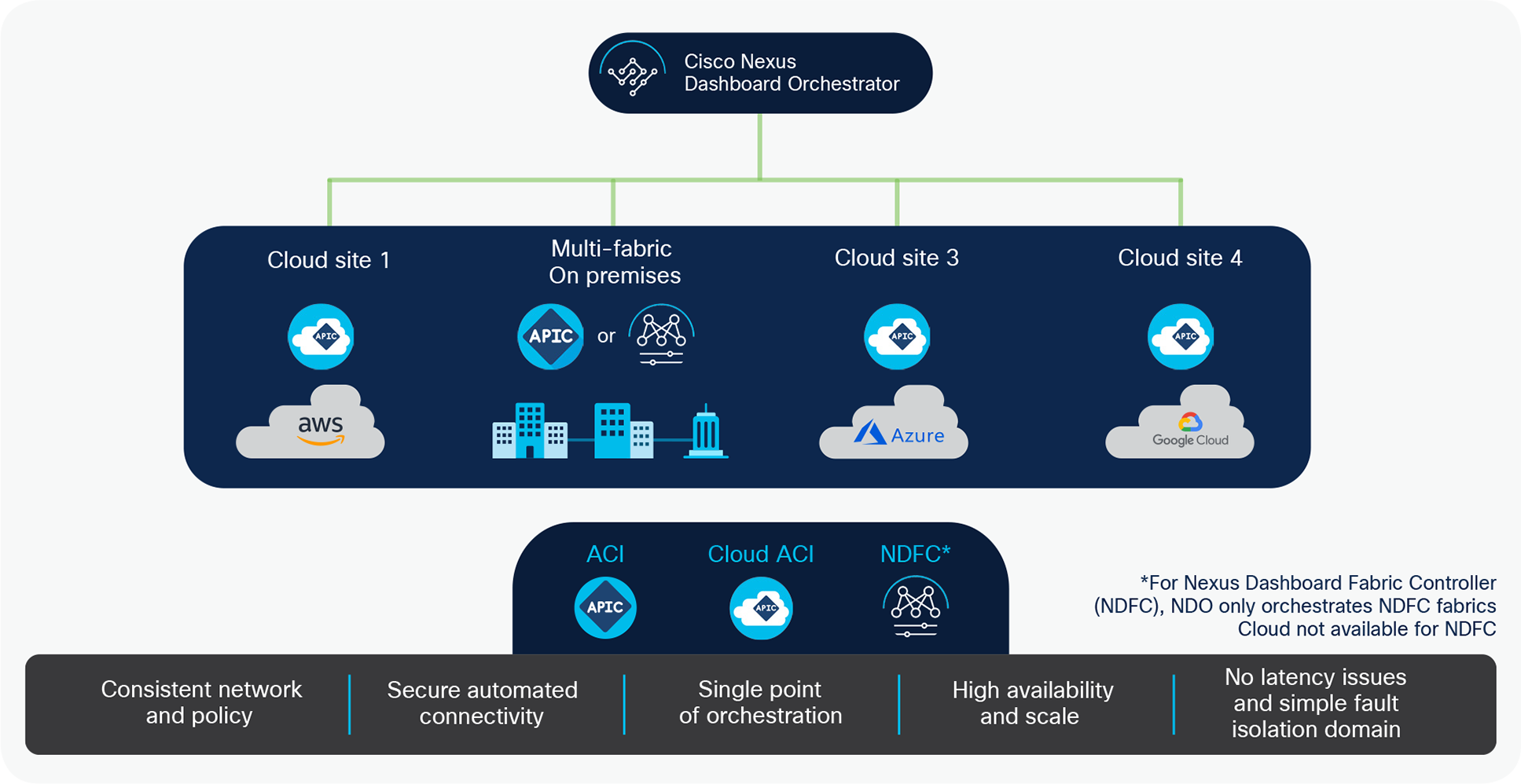
Cisco Nexus Dashboard Orchestrator overview
● Single pane of glass for administration and orchestration of multiple networking fabrics for both Cisco ACI and NDFC
● Automation of the configuration and management of intersite network interconnects across an IP backbone for both Cisco ACI and NDFC
● Consistent multitenant policy across multiple sites, which allows IP mobility, disaster recovery, and active/active use cases for data centers
● Capability to map tenants, applications, and associated networks to specific availability domains within the Cisco Multi-Site architecture for both Cisco ACI and NDFC
● Hybrid cloud and multi-cloud orchestration supporting on-premises Cisco ACI sites and public cloud sites (AWS and Azure)
● Capability to have multi-cloud ACI deployments without on-premises sites
● Scale out sites and leaf switches based on resource growth
Cisco Nexus Dashboard provides a single automation platform to access data center network operational services and tools. Today, you can deploy Cisco Nexus Dashboard Orchestrator, Cisco Nexus Insights, and Cisco Network Assurance Engine using the Cisco Nexus Dashboard platform. In the future, it will become even more of a collaborative focal point with the inclusion of operations-critical, third-party applications and tools. From the Cisco Nexus Dashboard, you can cross-launch any of the sites’ controllers, including APIC, Cloud APIC, and NDFC fabrics, a capability that drives the adoption of cloud-native application practices. Cisco Nexus Dashboard provides the following benefits:
● Easy to use:
◦ Customizable role-based UI provides focused views for specific use cases
◦ Single Sign-On (SSO) for seamless user experience across operation services
◦ Single console for health monitoring and quick turn-on of services
● Easy to scale:
◦ High-availability scale-out of operations from a single dashboard
◦ Capability to scale use cases by leveraging flexible deployment options
◦ Operations that span across on-premises, multi-cloud, and edge networks
● Easy to maintain:
◦ Seamless integration and lifecycle management of operational services
◦ Onboarding and managing of operational services across on-premises, cloud, or hybrid environments
◦ Single point of integration for critical third-party applications and tools
For Cisco ACI, NDO is the intersite policy manager. It provides single-pane management, enabling you to monitor the health-score state of all interconnected sites. It also allows you to define, in a centralized place, all intersite policies, which can then be pushed to different APIC domains for rendering them on the physical switches in those fabrics. This provides a high degree of control over when and where to deploy the policies, which in turn allows the tenant change domain separation that uniquely characterizes the Cisco Multi-Site architecture. With NDO, you can extend your policies to any site or multiple public clouds.
Cisco Nexus Dashboard Fabric Controller (NDFC) is the network management platform for all NX-OS–enabled deployments, spanning new fabric architectures, IP Fabric for Media, and storage networking deployments. It provides automation, visibility, and consistency within a NDFC-clustered fabric. NDO now enables network policy consistency and disaster recovery across multiple NDFC fabrics around the world through a single pane of glass and scale-out NDFC leaf switches to thousands of switches managed using one centralized policy.
There are several uses of Cisco Nexus Dashboard Orchestrator. Some of the main use cases include:
● Large scale data center deployment
● Data center interconnectivity
● Cisco NDO multi-domain integrations
● Hybrid cloud and multi-cloud
● Service provider – 5G telco
Large-scale data center deployment
For many organizations there is a pressing need run applications in highly distributed environments in a single geographic location.
It is critically important for enterprise IT to be able to run their environment in a distributed manner with multiple controllers across a single environment, enabling high availability without a single fault domain or single point of failure. Network policy must stay consistent and agile across these distributed environments with a single-pane of glass access to orchestration.
Some users require a Software-Defined-Network (SDN)–based data center solution that consists of a higher number of leaf switches (for example, 20,000) with a single management console for provisioning, orchestration, and policy consistency. Cisco NDO can meet these requirements to help build these large-scale data centers through:
● Easy provisioning and orchestration: A single pane of glass view to all leaf switches for consistent policy configuration allows you to deploy a VRF or BD/subnet to 20,000 leaf switches from a single console in seconds.
● Disaster recovery and high availability: A capability to partition a single large fault domain with 20,000 leaf switches to smaller isolated fault domains (“sites”). Each site can have up to 500 leaf switches.
● Enhanced scale: Sites can be scaled out horizontally to the scale of total leaf switches required.
● Business continuity: In a situation where a single site goes down (for example, due to a power failure), all other sites can continue normal operations without impact.
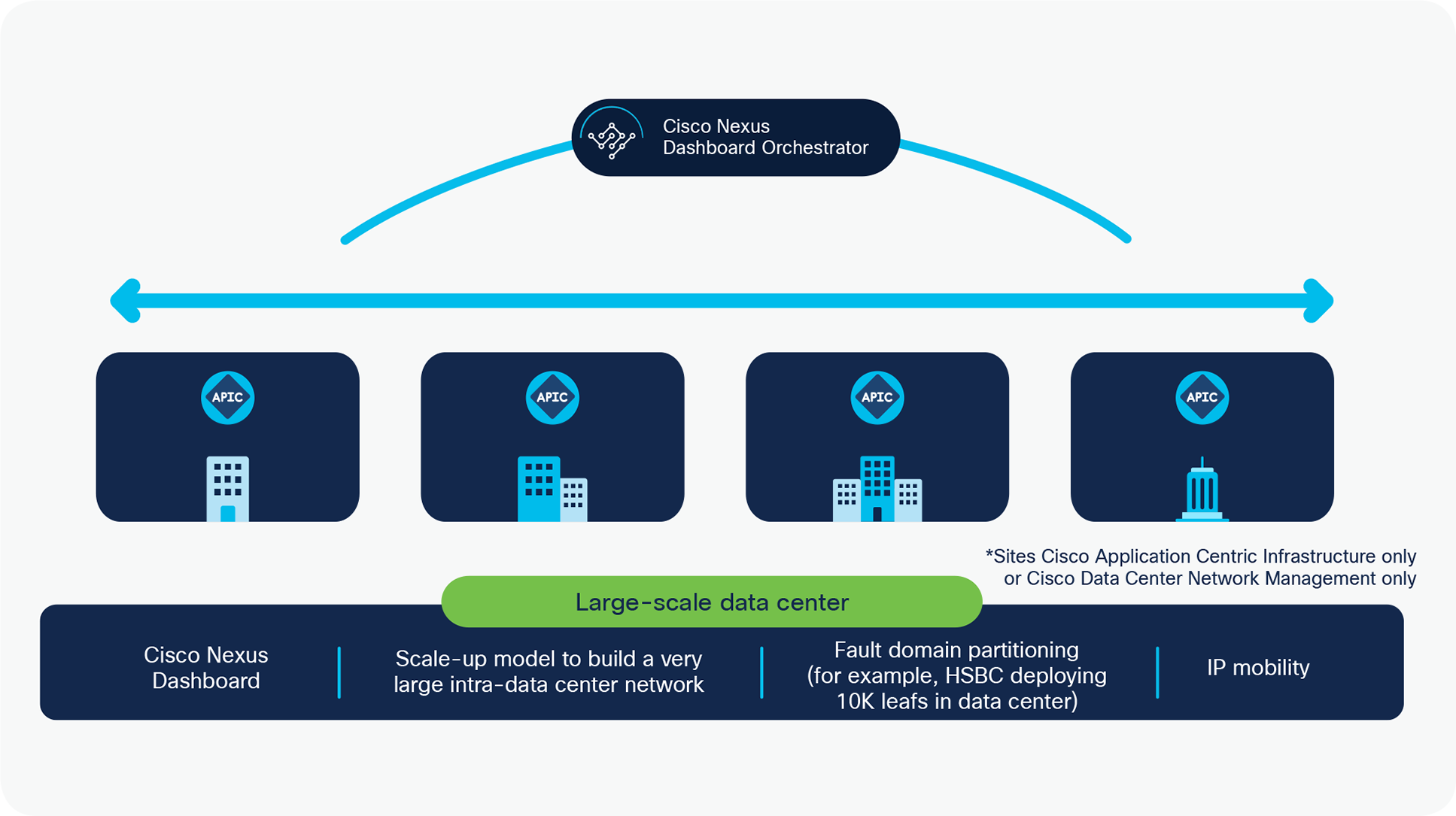
Large-scale data center deployment
Data center interconnectivity
Organizations, which include multinational corporations in fields such as insurance, retail, ecommerce, financial services, and transportation, as well as service providers that operate internationally, are required to manage and operate distributed application environments that span multiple sites and locations.
In many cases, these organizations must run applications in multiple data centers separated by vast distances that span continents, possibly the entire globe. The business drivers typically are applications, business continuity, and disaster recovery. For these organizations, it is imperative to keep business-critical applications available and responsive across geographically distributed sites. Because applications are how global organizations engage with their customers and realize business objectives, they must remain online constantly. Disruptions and outages incur large costs to organizations that have to deal with them, often resulting in lost revenue and possibly irrevocable damage to brand reputation.
Enterprises require a comprehensive architectural approach to a multi-site network infrastructure that addresses the evolution of applications toward microservices, the proliferation of workload locations, the growth of cloud, and the complexity of distributed management and operations. Application portability and resiliency are key priorities, with global organizations having an acute need to be able to move and distribute applications between multiple data centers and availability zones to meet the needs for business continuity and disaster recovery.
Cisco NDO extends intersite connectivity and network policy segmentation between loosely coupled data centers across multiple geographies, enabling agile deployment of where policies and security follow the movement of virtual machines across data centers. In addition, it enhances disaster recovery or active-active use cases spread across multiple sites and locations.
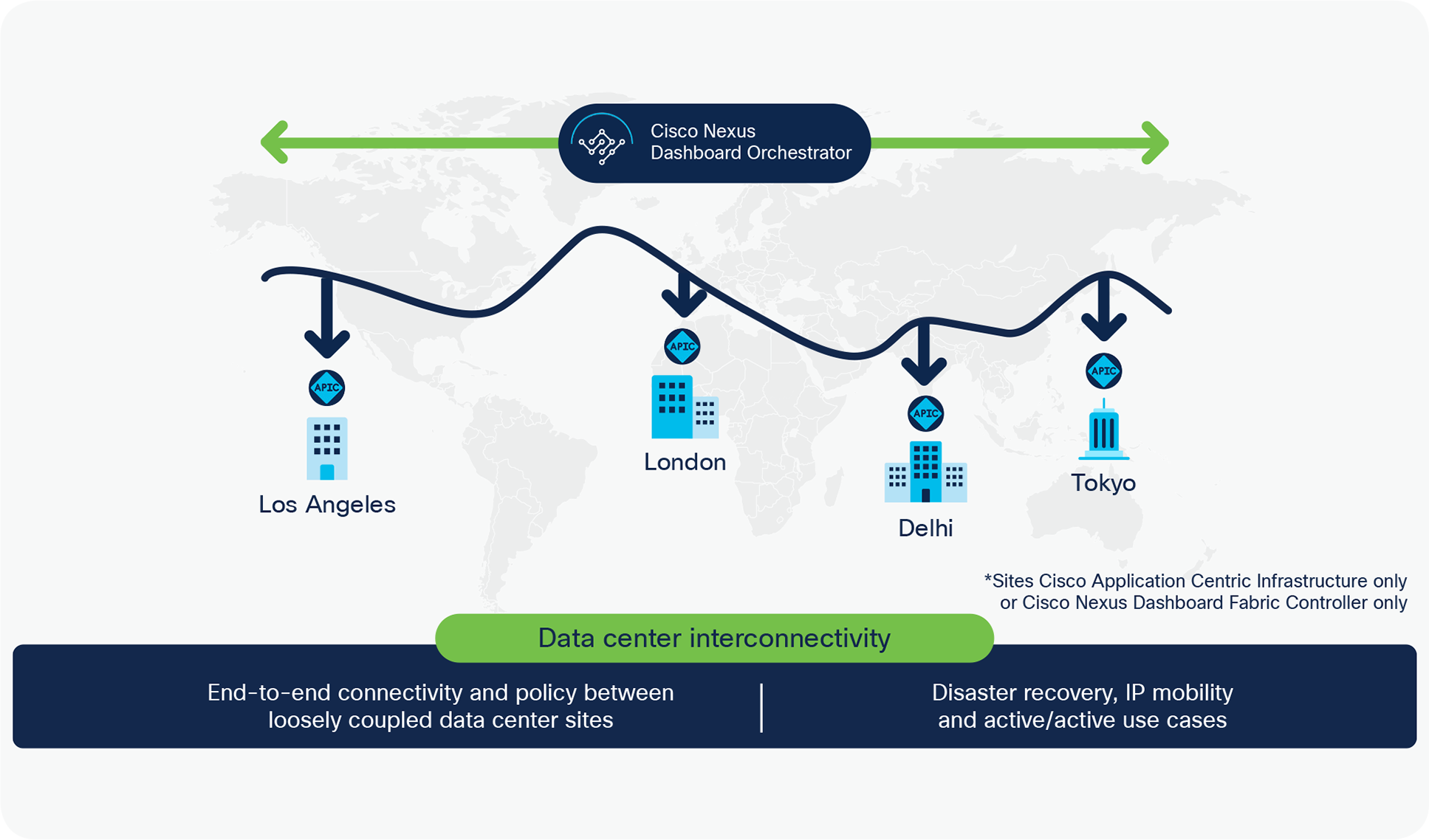
Data center interconnectivity
Cisco NDO multi-domain integrations (SD-WAN access policy)
Large and medium-sized organizations that have adopted a multi-site approach to their data centers have experienced performance degradation with unmanaged connections between the separate data centers. To assist customers with managing this, Cisco NDO has been integrated with Cisco’s SD-WAN.
Without SD-WAN, there is a chance of applications experiencing higher latency in the unmanaged connection as the underlay is not coupled tightly with the data center orchestration solution. Cisco NDO and SD-WAN integration provides application-aware, SLA-based routing in Cisco SD-WAN, which is used for interconnecting data center sites. With Cisco’s SD-WAN, customers connect any user to any application with integrated capabilities for multi-cloud, security, unified communications, and application optimization with low latency.
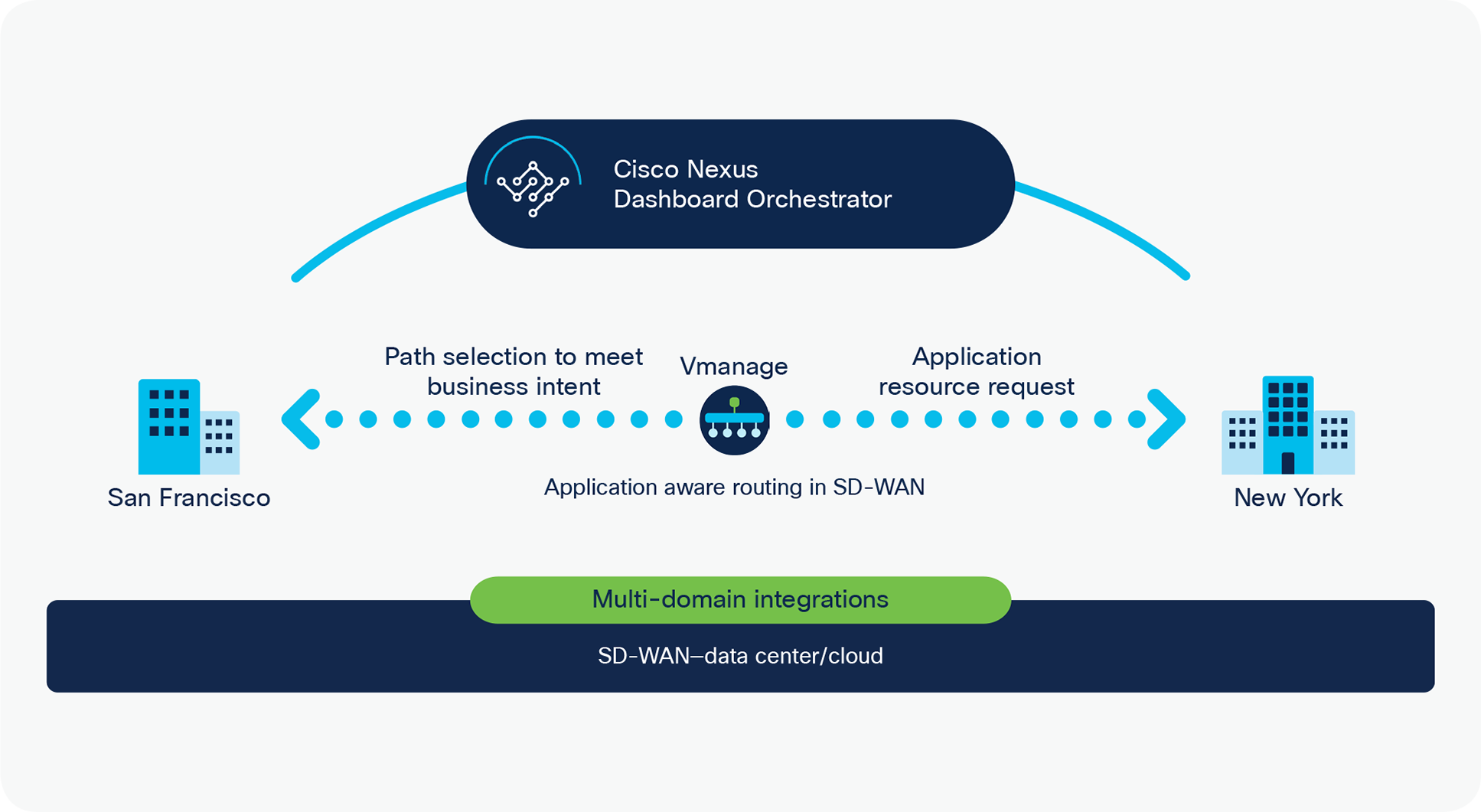
Multi-domain integrations
Hybrid cloud and multi-cloud
According to a recent industry survey, 42 percent of applications will continue to be deployed on premises, with half of those being deployed in a private cloud (21 percent of all applications) and the other half remaining on traditional on-premises infrastructure.
Cisco NDO expands networking functions to cloud sites and automates the creation of overlay connectivity between all sites (on premises and in the public cloud).
As the central orchestrator of intersite policies, Cisco NDO allows for pushing the same policies to multiple data centers and public clouds across the globe in a single step.
Cisco NDO supports Cisco ACI policy extensions to the public cloud (AWS and Azure), allowing for hybrid-cloud and multi-cloud deployments. In both cases, NDO enables automated and secure interconnect provisioning, consistent policy enforcement for on-premises sites and the public cloud, and simplified operations for end-to-end visibility.
In hybrid-cloud deployments, NDO extends the on-premises site’s policies to public cloud sites; while in multi-cloud deployments, NDO extends policies between public cloud sites that have no on-premises sites.
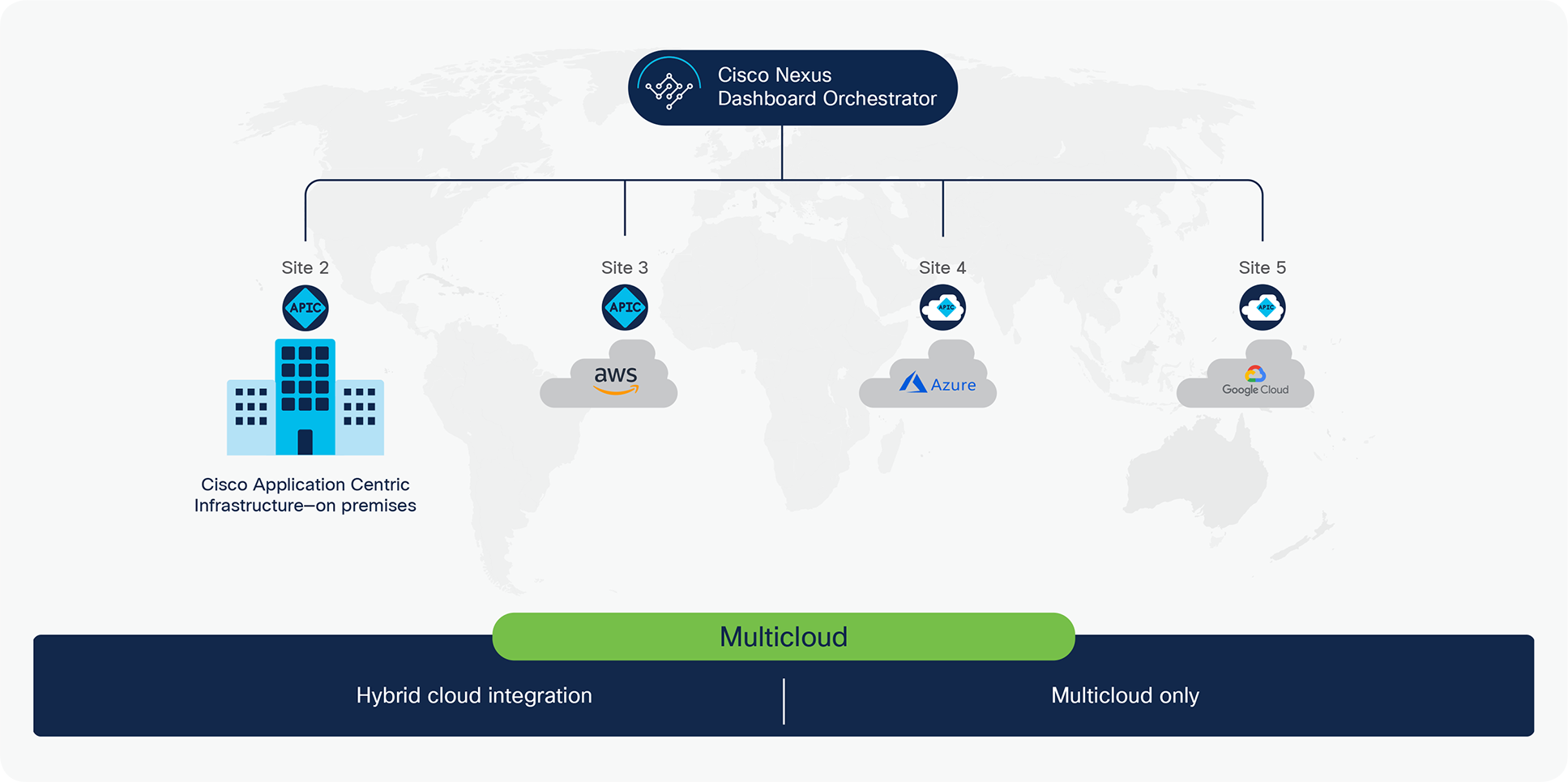
Hybrid and multi-cloud
5G transformations are challenging telecom providers to develop data-center networks of the future that can seamlessly scale, automate, and integrate their infrastructure from the central data center to the edge and across the transport network. This requires the adoption of an end-to-end programmable SDN-enabled approach across data center applications and the service provider’s transport backbone. Cisco NDO provides:
● Automation of SR-MPLS policies that can be centrally orchestrated across the 5G telco cloud sites (central, regional, and edge data centers).
● Consistent SR-MPLS handoff transport and application slice interworking between 5G telco cloud sites and the service provider’s transport backbone.
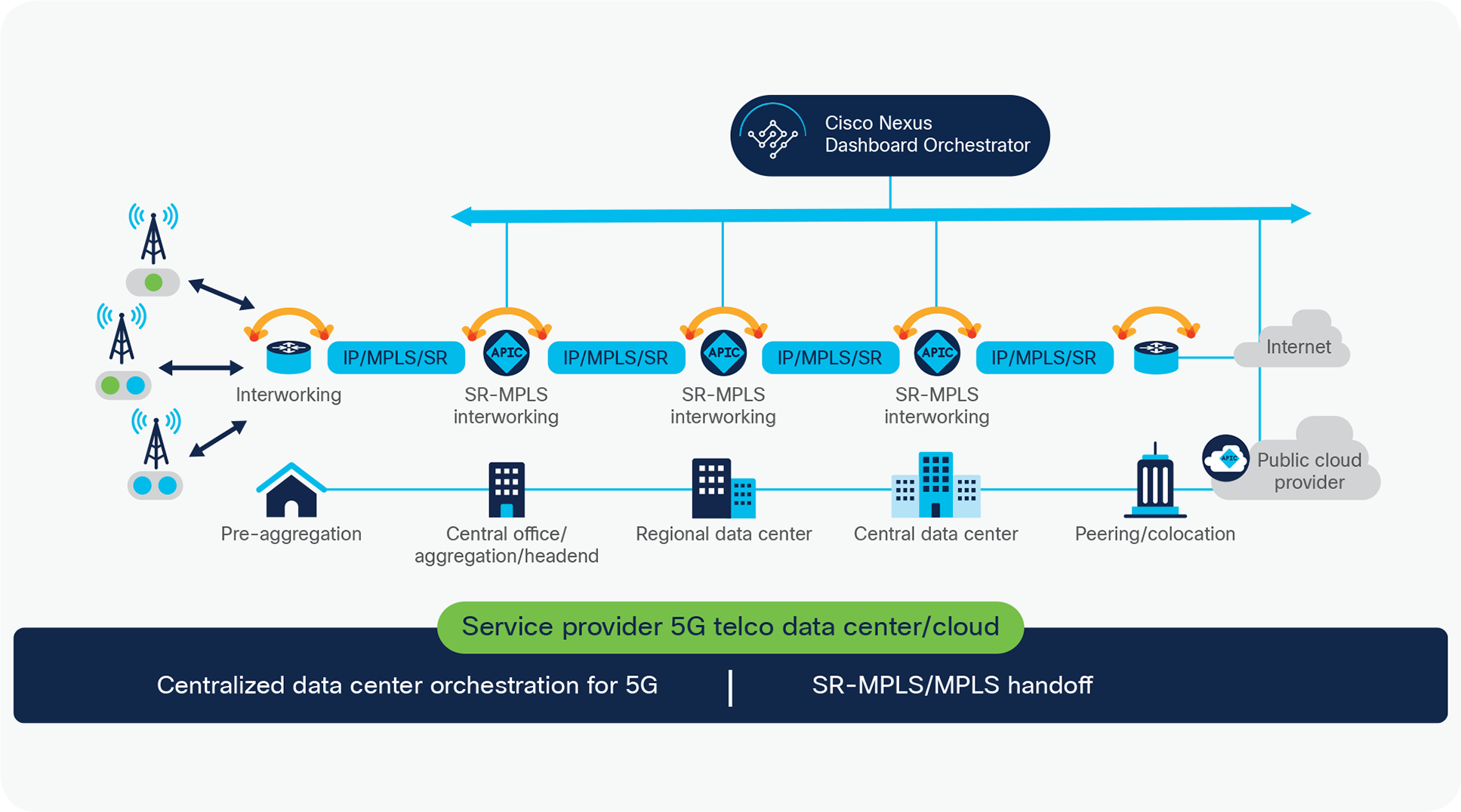
Service provider – 5G telco
Organizations are having to rapidly adapt to a changing world. They must be agile and automated.
Through a single pane of glass, Cisco Nexus Dashboard Orchestrator (NDO) provides consistent network and automated policy orchestration, scalability, and disaster recovery across multiple data centers allowing the data center to go wherever the data is.